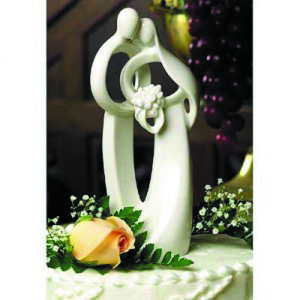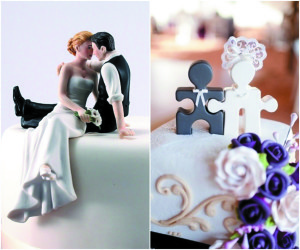Symbols of love and togetherness, figures of the bride and groom have adorned the traditional wedding cake for well over a century.
They are known affectionately as toppers.
The most famous of all wedding cake toppers, the bride and groom, are no longer just keepsakes of the newly weds. They, like so many other vintage wedding items, are attracting collectors.
“Once considered valuable only to the persons who owned them,” proclaims the Antique Trader Antiques and Collectibles Price Guide, “wedding cake toppers have become increasingly sought after collectibles.”
While wedding cakes were frequently seen at gala weddings throughout the 19th century, most sources agree that wedding cake toppers first came into fashion in the 1890s.
 Bells, flowers, and other artifacts decorated wedding cakes of that era. But especially charming were the bride and groom toppers which could be then removed from the cake a treasured as a keepsake by the happily wedded couple.
Bells, flowers, and other artifacts decorated wedding cakes of that era. But especially charming were the bride and groom toppers which could be then removed from the cake a treasured as a keepsake by the happily wedded couple.
Early examples of such figures were usually made of plaster or a gum paste, but other materials were also pressed into use depending on the creativity of the baker or the homemaker.
Toppers of the 1900s could simply be figures of the bride and groom. However there were an increasing number of options such as adding love birds, silver bells, and archway, or even placing the symbolic couple in a miniature gazebo.
The dawning of the 20th century gradually saw bride and groom wedding cake toppers made of various substances including paper, glass, and wood. Some were simply homemade, but an increasing number were commercially manufactured in America as well as Germany and Japan.
Not that the wedding cake and its delightful toppers needed any help, but they became officially acceptable in high society by the 1920.
The “wedding cake is an essential of every wedding reception,” wrote in immortal etiquette expert Emily Post in her 1922 book.
Miss Post added, “the wedding cake is almost always ordered from the caterer who delivers it shortly before the hour of the reception. It is usually in several tiers, beautifully decorated with white icing and topped by small figures of the bride and groom.”
However the etiquette lady, who would write volumes on the subject, warned such layouts could be expensive:
“Although the cost of ordering such a cake (complete with adorable topper figures) may be prohibitive, the charm remains, and it might be a suggestion for an unusual and thoughtful wedding gift from a family friend who is skilled in the art of baking—-or very rich.”
In 1924 one U.S. wholesale catalog was offering an assortment of wax bride and groom wedding cake toppers. Selections included a hatless groom or a groom wearing a “high hat” or top hat. The bride meanwhile could come with or without a cloth veil. All of the bride and groom wax figures were about two inches tall. The catalog listing offered them as a couple, or in groups of 100 for wedding favors.
Also listed under “wedding favors and novelties” in the catalog were a cupid with a bow and arrow, cupid with a violin, cupid with a banjo, dove, lamb, dog, and a stork. Additionally there were also gnome figures in four styles and assorted colors.
Appearing in the marketplace recently was a ceramic bride and groom wedding topper from a 1925 event. The china figures compete with original cellophane paper and crepe paper wedding bell came with an original wedding invitation proclaiming the date. Overall the original wedding topper piece stood about seven inches tall.
The idea of wedding toppers in general and bride and groom toppers in particular had expanded enough in 1927 for the Sears and Roebuck mail order catalog it include a whole page of wedding cake ornaments. The following year Slack Manufacturing offered bride and groom figures made of celluloid. The bride wore a paper dress and the groom wore a paper suit. Both figures were about two and a half inches tall.
There were lots more celluloid imported into the United States during the 1930s. Other choices included bisque, chalk ware, and even crepe paper. Professional cake makers sometimes went to great lengths to represent the bride and groom on towering cakes. One example featured two seven inch tall white china figures upon a three-inch silk floral accented base. Instead of merely standing side by side, this time the groom was carrying the bride over the threshold in traditional fashion.
Still other toppers of that era incorporated combinations of paper, wood, and perhaps metal. For a time tiny silver bells were a popular added decoration.
During the 1940s, with the onset of World War II, the groom topper figure often appeared in a military uniform. Army, Navy, and Marine versions were made. Some wore dress uniforms while others appeared in the more casual regular military duty attire. One chalk ware version had the groom in a U.S. Navy officer’s uniform beside a bride holding silk flowers. The over all piece including archway was six inches tall.
Yet another rare 1940s wedding cake topper put the chalk ware bride and groom in a hot air balloon, apparently about to embark on a lifetime journey.
Elaborations and materials varied considerably in the 1950s and 1960s. In the late 1950s the Coast Novelty Company produced a bride and groom topper holding hands beneath an arch. The arch itself was decorated with fabric flowers, and the plastic bride wore a gown of white satin. Early in the 1960s Wilton marketed a plastic couple complete with a battery operated light in the wedding bell above them.
Vintage Wedding Cake Toppers by Penny Henderson offers very generous coverage of such items from the 1890s through the 1980s. As an aide to dating various wedding couple toppers the book provides extensive comparisons on clothing styles. Also included are examples of the many substances used in construction including earthenware, glass, marble-like, metal, plastic, and porcelain.
“Some collectors specialize in particular eras,” according to Henderson, “but I find that the majority of collectors, like me, collect every time period and every variety they can find.”
On occasion toppers were marked or even dated by the manufacturer. Generally however they lacked such details, leaving the collector to depend on other means. Clues include clothing styles of course, hairstyles, and vintage wedding photographs. The Henderson book includes 600 topper photographs as well as values.
Besides brides and grooms, the wedding topper field also expands to include doves, the bridal shoe, wax hands, cherubs, bells, and other decorative adornments relating to love and marriage.
“My love and passion for wedding cake toppers will never end,” concludes author Henderson.
Recommended reading:
Vintage Wedding Cake Toppers by Penny Henderson (Schiffer Publishing).
















Follow Us